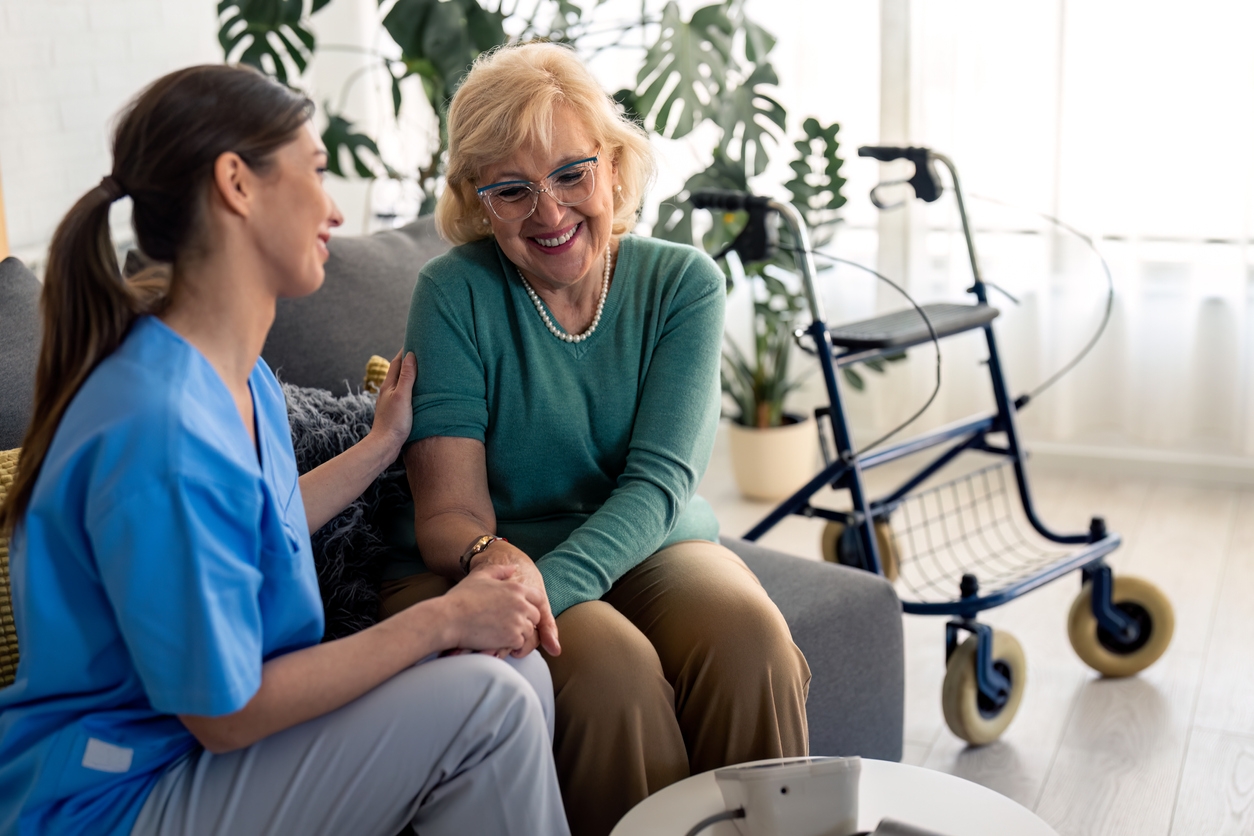Aging in place works best when a professional team tailors the home care plan to the person – not when families DIY a few grab bars and hope for the best. Most homes weren’t designed with older adults in mind, 1 in 4 older adults report a fall each year, and evidence-based frameworks recommend multifactorial assessments that look at the home, health, medications, and mobility together.
What Safe Aging in Place Really Requires
Safe, confident living at home depends on four pillars working in sync: the home environment, functional ability, care coordination, and financing/coverage. Tools like the AARP HomeFit Guide are a great starting point for a walk-through, but long-term safety usually calls for expert eyes and a coordinated plan.
If you’re just beginning, our Aging in Place Roadmap walks families through early steps and common pitfalls.
Why Aging in Place Needs Experts, Not DIY Fixes
- Occupational Therapist (OT). OTs conduct standardized home and task assessments, recommend adaptive equipment, train clients and family, and document medical necessity when applicable. Medicare coverage for OT is conditional (e.g., in certain home-health episodes), which is precisely why families benefit from guidance instead of guessing.
- CAPS-Certified Remodeler. A Certified Aging-in-Place Specialist understands safety codes, slip resistance, lighting/contrast, doorway/threshold solutions, and proper blocking/anchoring for grab bars – work that goes beyond weekend projects.
- Physical Therapist (PT). PTs assess balance and gait and create strengthening plans aligned to STEADI (Stopping Elderly Accidents, Deaths & Injuries).
- Primary Care/Pharmacist. A medication review reduces dizziness and polypharmacy risks – a key part of multifactorial fall prevention.
- Care Manager (Aging Life Care Professional). Helps families coordinate services, benefits, and communication so the plan actually happens. (If you already have one, we’ll collaborate.)
- Home Care Team (ComForCare). We support daily living – companionship & routines, light housekeeping for safety, meal preparation, medication reminders, transportation, and fall-risk checks – and we keep a caring eye on changes between clinical visits.
Proof it works (and why “just grab bars” isn’t enough)
- Risk is real: Over 14 million older adults – about 1 in 4 – report a fall each year. Falls can lead to injury, fear of falling, and loss of independence.
- Best practice: The CDC’s STEADI framework calls for multifactorial assessment (home hazards, balance, vision, footwear, meds), not one-off fixes.
- Homes weren’t built for this: Even the AARP notes most housing stock wasn’t designed for older adults – another reason to bring in trained pros.
If falls are your top concern, share Fall Prevention 101 with your family – practical steps you can start today.
Costs & coverage (clear and honest)
- Benchmark costs: In 2024, the national median private-pay rate for a home health aide is $34/hour. This context helps families right-size hours and budget.
- What Medicare covers (and doesn’t): Medicare generally doesn’t cover long-term custodial care or home modifications; OT/home-health benefits are specific and time-limited. Planning with professionals prevents surprises.
For families navigating a hospital discharge, our guide to transitional care at home explains how to bridge services safely.
A simple, expert-led plan (from first visit to follow-up)
- Quick self-scan with NIA/AARP tips to surface concerns.
- OT home safety evaluation (function, transfers, equipment, bathroom plan).
- CAPS design + quotes for the right modifications (curbless shower, lighting, grab-bar blocking, thresholds).
- PT balance & strength plan, plus medication review (dizziness/fall-risk meds).
- Implement + caregiver training so the new setup is used safely.
- Home care support for routines, nutrition, light housekeeping, and ongoing observation – adjust hours as needs change.
- Re-evaluate after any health event (new meds, surgery, or a near-fall).
When day-to-day risk rises (nighttime wandering, frequent bathroom trips, recovery periods), families often move to 24-hour at-home care for continuous safety and peace of mind.
Common DIY mistakes to avoid
- Anchoring grab bars into drywall (no blocking), or placing them out of reach.
- Throw rugs, poor lighting, and low-contrast steps that hide edges.
- Mis-fit walkers/canes and no plan for night-time bathroom trips.
- Skipping med reviews that could reduce dizziness or interactions.
If you’re noticing more “little slips,” start with Recognizing When In-Home Care Is Needed – it’s a gentle checklist to start the conversation.
FAQs
Isn’t a checklist enough? Checklists are useful first steps, but risk lives at the intersection of home hazards, balance, vision, footwear, and medications. That’s why STEADI emphasizes a multifactorial approach delivered by trained professionals.
Who pays for home modifications? Medicare generally doesn’t pay for home modifications. Some costs may be offset by Medicaid waivers or local programs; OT and home-health benefits have specific rules. An expert team will outline options before you spend.
Where can we learn the basics without getting overwhelmed? The NIA and AARP HomeFit guides are excellent primers, and our Companion Care and Light Housekeeping articles show what supportive, day-to-day help looks like.
What if dementia is part of the picture? Consistency and specialized training matter. Our DementiaWise® approach helps caregivers create better days while keeping routines safe and familiar.
A Safer Home Starts with Support, Not Guesswork
Aging in place is about more than staying in a familiar space — it’s about preserving dignity, comfort, and peace of mind. But safety doesn’t happen by accident. Behind every confident step down the hallway or restful night’s sleep is a thoughtful plan made by people who care. At ComForCare, we believe families shouldn’t have to navigate this alone. With the right experts by your side — and the right care team in your corner — home can remain the safest place to be.
Let’s take the next step together. Reach out to your local ComForCare office to start building a safer tomorrow, today.


